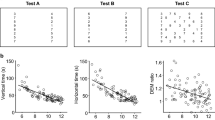Abstract
Background
The relationship between oculomotor scanning and reading in poor readers of primary school age is not well known. This study was designed to assess this relationship by determining mean Developmental Eye Movement (DEM) test times and reading speeds in a Spanish non-clinical population of children with poor reading skills but without dyslexia.
Methods
We conducted a cross-sectional study on 81 poor readers (8–11 years of age) in the third to fifth grades recruited from 11 elementary schools in Madrid, Spain. In each subject with best spectacle correction, oculomotor scanning was measured using the DEM test, and reading speed (words per minute) was assessed by a standardized Spanish contextual reading test.
Results
Mean horizontal DEM times were higher than normative values for children in the third, fourth and fifth grades, by 20 seconds, 12 seconds, and 3 seconds respectively. Mean reading speeds were 18 words per minute lower than the norm for the third and fourth grades respectively, and 30 words per minute lower than the norm for the fifth grade. Reading speeds were significantly related to horizontal DEM times (r = −0.53, p < 0.0001). Thus, children showing a longer, or worse, horizontal DEM time achieved lower reading speeds.
Conclusions
Poor readers showed poor horizontal scanning as assessed by the DEM test that was related to a slow reading speed. This test should be used by optometric clinicians as a screening tool to help identify poor reading skills in school children at an early stage.




Similar content being viewed by others
References
Vogel G (1995) Saccadic eye movements: theory, testing & therapy. J Behav Optom 6:3–12
Pavlidis GT (1981) Do eye movements hold the key to dyslexia? Neuropsychologia 19:57–64, doi:10.1016/0028-3932(81)90044-0
Bucci M, Brémond-Gignac D, Kapoula Z (2008) Poor binocular coordination of saccades in dyslexic children. Graefes Arch Clin Exp Ophthalmol 246:417–428, doi:10.1007/s00417-007-0723-1
Garzia R, Richman J, Nicholson S, Gaines C (1990) A new visual verbal saccade test. The Developmental Eye Movement test (DEM). J Am Optom Assoc 61:124–135
Poynter H, Schor C, Haynes H, Hirsch J (1982) Oculomotor functions in reading disability. Am J Optom Physiol Opt 59:116–127
Kulp M, Schmidt P (1997) The relation of clinical saccadic eye movement testing to reading in kindergartners and first grades. Optom Vis Sci 74:37–42, doi:10.1097/00006324-199701000-00018
Stein J, Fowler M (1993) Unstable binocular control in dyslexic children. J Res Read 16:30–45, doi:10.1111/j.1467-9817.1993.tb00033.x
Eden GF, Stein JF, Wood HM, Wood FB (1994) Differences in eye movements and reading problems in dyslexic and normal children. Vision Res 34:1345–1358, doi:10.1016/0042-6989(94)90209-7
Richman J, Garzia R (1987) Developmental Eye Movement Test, version 1. Bernel Corp, South Bend, IN, USA
Larter S, Herse P, Naduvilath T, Dain S (2004) Spatialload factor in prediction of reading performance. Ophthalmic Physiol Opt 24:440–449, doi:10.1111/j.1475-1313.2004.00219.x
Fernandez-Velazquez F, Fernandez-Fidalgo M (1995) Do DEM test scores change with respect to the language? Norms for spanish-speaking population. Optom Vis Sci 72:902–906, doi:10.1097/00006324-199512000-00009
Jimenez R, Gonzalez MD, Perez MA, García JA (2003) Evolution of accommodative function and development of ocular movements in children. Ophthalmic Physiol Opt 23:97–107, doi:10.1046/j.1475-1313.2003.00093.x
McMahon TT, Hansen M, Viana M (1991) Fixation characteristics in macular disease. Relationship between saccadic frequency, sequencing, and reading rate. Invest Ophthalmol Vis Sci 32:567–574
Northway N (2003) Predicting the continued use of overlays in school children—a comparison of the Developmental Eye Movement test and the rate of reading test. Ophthalmic Physiol Opt 23:457–464, doi:10.1046/j.1475-1313.2003.00144.x
Cuetos F, Rodriguez B, Ruano E (2000). Evaluación de los procesos lectores PROLEC, (Madrid).
Ramos J, Cuetos F (1999). Evaluación de los procesos lectores PROLEC-SE, (Madrid).
Palomo-Álvarez C, Puell MC (2008) Accommodative function in school children with reading difficulties. Graefes Arch Clin Exp Ophthalmol 246:1769–1774, doi:10.1007/s00417-008-0921-5
Rouse M (2006) Optometric assessment: visual efficiency problems. In: Scheiman M, Rouse M (eds) Optometric management of learning-related vision problems, 2nd edn. Mosby Elsevier, Philadelphia, pp 335–367
Sprenger-Charolles L, Siegel L, Bèchennec D, Serniclaes W (2003) Development of phonological and orthographic processing in reading aloud, in silent reading and in spelling: a four-year longitudinal study. J Exp Child Psychol 84:194–217, doi:10.1016/S0022-0965(03)00024-9
Ziegler J, Goswami U (2005) Reading acquisition, developmental dyslexia, and skilled reading across languages: a psycholinguistic grain size theory. Psychol Bull 131:3–29, doi:10.1037/0033-2909.131.1.3
Acknowledgments
This research was supported by a grant from Prats Optical S.A. The authors would like to thank Miguel Florido and Visual Global for logistic support, and the following schools in Madrid for their collaboration: El Prado, Chamberí, Blanca de Castilla, San Rafael Arcangel, Sagrado Corazón, Luyferivas, SEK Santa Isabel, Santo Angel de la Guarda, Valdeluz, Virgen de Mirasierra and Las Tablas. We also gratefully acknowledge the children who participated in this study, and their parents.
The authors declare no commitments with the company that supported this study with regard to the results obtained.
Author information
Authors and Affiliations
Corresponding author
Additional information
This research was supported by a grant from Prats Optical S.A.
Human subjects and informed consent
The authors declare that this research was performed following the tenets of the Declaration of Helsinki, and that informed consent was obtained from the subjects after the nature of the study had been explained to them in detail. The study protocol was approved by the Clinical Research Ethics Committee of the School of Optometry.
Rights and permissions
About this article
Cite this article
Palomo-Álvarez, C., Puell, M.C. Relationship between oculomotor scanning determined by the DEM test and a contextual reading test in schoolchildren with reading difficulties. Graefes Arch Clin Exp Ophthalmol 247, 1243–1249 (2009). https://doi.org/10.1007/s00417-009-1076-8
Received:
Revised:
Accepted:
Published:
Issue Date:
DOI: https://doi.org/10.1007/s00417-009-1076-8




